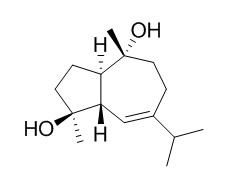Alismoxide
Alismoxide shows an inhibitory effect on the contraction of isolated bladder smooth muscle induced by carbachol; it demonstrates cytostatic action in HeLa cells, revealing potential use in virostatic cocktails. Alismoxide has inhibitory effects on vascular contraction induced by high concentration of KCl; it also shows an inhibitory effect on the direct passive Arthus reaction (DPAR) in rats in the type III allergic model.
Inquire / Order:
manager@chemfaces.com
Technical Inquiries:
service@chemfaces.com
Tel:
+86-27-84237783
Fax:
+86-27-84254680
Address:
1 Building, No. 83, CheCheng Rd., Wuhan Economic and Technological Development Zone, Wuhan, Hubei 430056, PRC
Providing storage is as stated on the product vial and the vial is kept tightly sealed, the product can be stored for up to
24 months(2-8C).
Wherever possible, you should prepare and use solutions on the same day. However, if you need to make up stock solutions in advance, we recommend that you store the solution as aliquots in tightly sealed vials at -20C. Generally, these will be useable for up to two weeks. Before use, and prior to opening the vial we recommend that you allow your product to equilibrate to room temperature for at least 1 hour.
Need more advice on solubility, usage and handling? Please email to: service@chemfaces.com
The packaging of the product may have turned upside down during transportation, resulting in the natural compounds adhering to the neck or cap of the vial. take the vial out of its packaging and gently shake to let the compounds fall to the bottom of the vial. for liquid products, centrifuge at 200-500 RPM to gather the liquid at the bottom of the vial. try to avoid loss or contamination during handling.
J Biochem Mol Toxicol.2021, 35(5):e22731.
Phytother Res.2019, 33(5):1490-1500
iScience.2023, 26(9):107602.
Molecules.2019, 24(1):E159
Chemistr of plant2016, 2016021195
The Journal of Supercritical Fluids2021, 176:105305.
J Clin Med.2022, 11(13):3662.
Comput Biol Chem.2019, 83:107096
Food Hydrocolloids2024, 156:110345
Front Pharmacol.2022, 13:883475.
Related and Featured Products
Mar Drugs. 2013 Dec 10;11(12):4917-36.
Cytotoxic, cytostatic and HIV-1 PR inhibitory activities of the soft coral Litophyton arboreum.[Pubmed:
24336129]
Bioassay-guided fractionation using different chromatographic and spectroscopic techniques in the analysis of the Red Sea soft coral Litophyton arboreum led to the isolation of nine compounds; sarcophytol M (1), alismol (2), 24-methylcholesta-5,24(28)-diene-3β-ol (3), 10-O-methyl Alismoxide (4), Alismoxide (5), (S)-chimyl alcohol (6), 7β-acetoxy-24-methylcholesta-5-24(28)-diene-3,19-diol (7), erythro-N-dodecanoyl-docosasphinga-(4E,8E)-dienine (8), and 24-methylcholesta-5,24 (28)-diene-3β,7β,19-triol (9).
METHODS AND RESULTS:
Some of the isolated compounds demonstrated potent cytotoxic- and/or cytostatic activity against HeLa and U937 cancer cell lines and inhibitory activity against HIV-1 protease (PR). Compound 7 was strongly cytotoxic against HeLa cells (CC₅₀ 4.3 ± 0.75 µM), with selectivity index of SI 8.1, which was confirmed by real time cell electronic sensing (RT-CES). Compounds 2, 7, and 8 showed strong inhibitory activity against HIV-1 PR at IC₅₀s of 7.20 ± 0.7, 4.85 ± 0.18, and 4.80 ± 0.92 µM respectively. In silico docking of most compounds presented comparable scores to that of acetyl pepstatin, a known HIV-1 PR inhibitor. Interestingly, compound 8 showed potent HIV-1 PR inhibitory activity in the absence of cytotoxicity against the cell lines used. In addition, compounds 2 and 5 demonstrated cytostatic action in HeLa cells, revealing potential use in virostatic cocktails.
CONCLUSIONS:
Taken together, data presented here suggest Litophyton arboreum to contain promising compounds for further investigation against the diseases mentioned.
Biol Pharm Bull. 1997 May;20(5):511-6.
Studies on Alismatis rhizoma. I. Anti-allergic effects of methanol extract and six terpene components from Alismatis rhizoma (dried rhizome of Alisma orientale).[Pubmed:
9178931]
Methanol and aqueous extracts (TMe-ext and TAq-ext) from dried rhizomes of Alisma orientale have been screened for activity in experimental models of type I-IV allergies.
METHODS AND RESULTS:
In the type III allergic model, TMe-ext at oral doses of 50, 200 mg/kg showed an inhibitory effect on the direct passive Arthus reaction (DPAR) in rats, while TAq-ext did not. Four triterpenes (alisol A, alisol B, alisol A monoacetate and alisol B monoacetate) and two sesquiterpenes (alismol and Alismoxide) isolated from TMe-ext also exhibited this inhibitory effect. In a type I allergic model, TMe-ext inhibited 48-h homologous passive cutaneous anaphylaxis (PCA) in rats. In a type II allergic model, it was found that TMe-ext inhibits reversed cutaneous anaphylaxis (RCA) in rats. Furthermore, in a type IV allergic model, TMe-ext had an inhibitory effect on the induction phase in picryl chloride-induced contact dermatitis (PC-CD) in mice.
CONCLUSIONS:
These results indicate that Alismatis Rhizoma not only inhibits antibody-mediated allergic reactions but also influences cell reactions and should be recognized as a material for the treatment of allergic reactions, and the anti-type III allergic components are partially attributable to the terpenes mentioned above.
Chem. Soc. Japan, 1994, 67(5):1394-8.
Inhibitory Effects and Active Constituents of Alisma Rhizomes on Vascular Contraction Induced by High Concentration of KCl.[Reference:
WebLink]
The acetone extract of Alisma rhizomes were found to possess inhibitory effects on vascular contraction induced by high concentration of KCl.
METHODS AND RESULTS:
With the aids of bioassay, the effective components were pursued by purification with chromatographies, resulting in the characterization of six protostane type triterpenes (alisol C and its analogues) and a known sesquiterpene, Alismoxide as the active compounds.
Chem Pharm Bull (Tokyo). 1994 Sep;42(9):1813-6.
Crude drugs from aquatic plants. IV. On the constituents of alismatis rhizoma. (2). Stereostructures of bioactive sesquiterpenes, alismol, alismoxide, orientalols A, B, and C, from Chinese alismatis rhizoma.[Pubmed:
7954931]
METHODS AND RESULTS:
Following the characterization of the triterpene constituents in Chinese Alismatis Rhizoma, we investigated the chemical structures of orientalols A, B, and C, isolated from the less polar fraction of the crude drug together with two known sesquiterpenes, alismol and Alismoxide. On the basis of the chemical and physicochemical evidence, the structures of orientalols A, B, and C have been determined and those of alismol and Alismoxide were revised.
CONCLUSIONS:
All five sesquiterpenes were found to show an inhibitory effect on the contraction of isolated bladder smooth muscle induced by carbachol.



